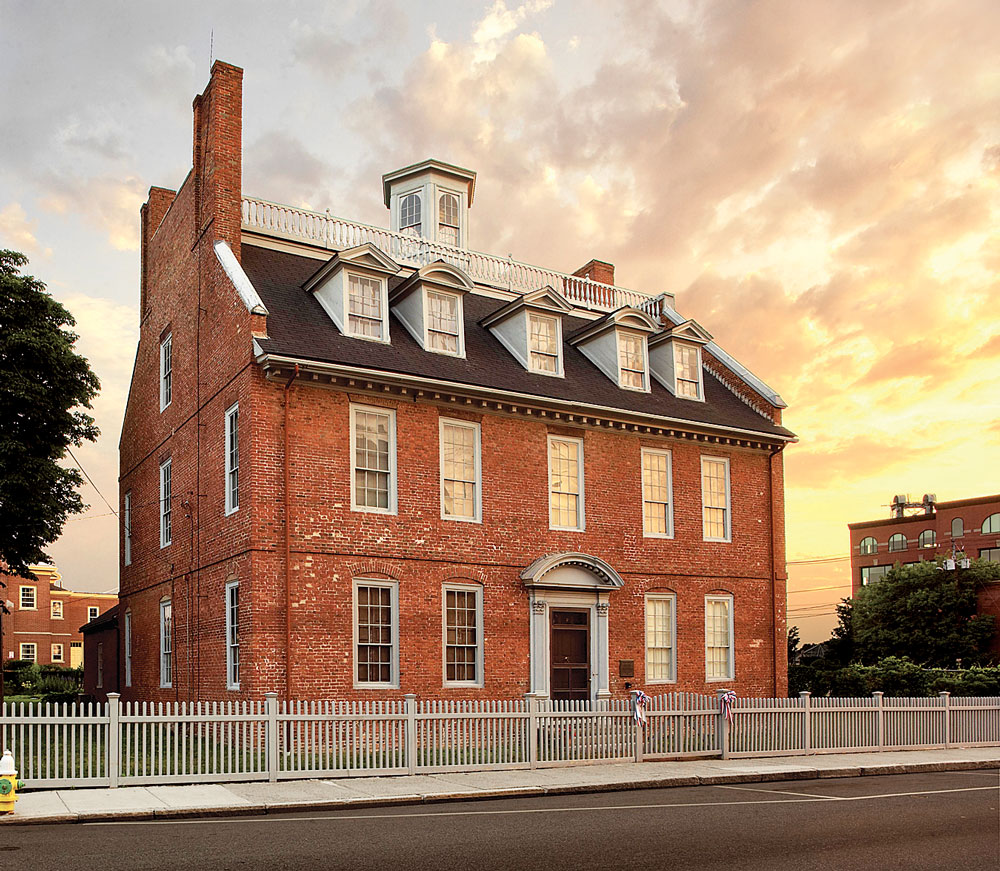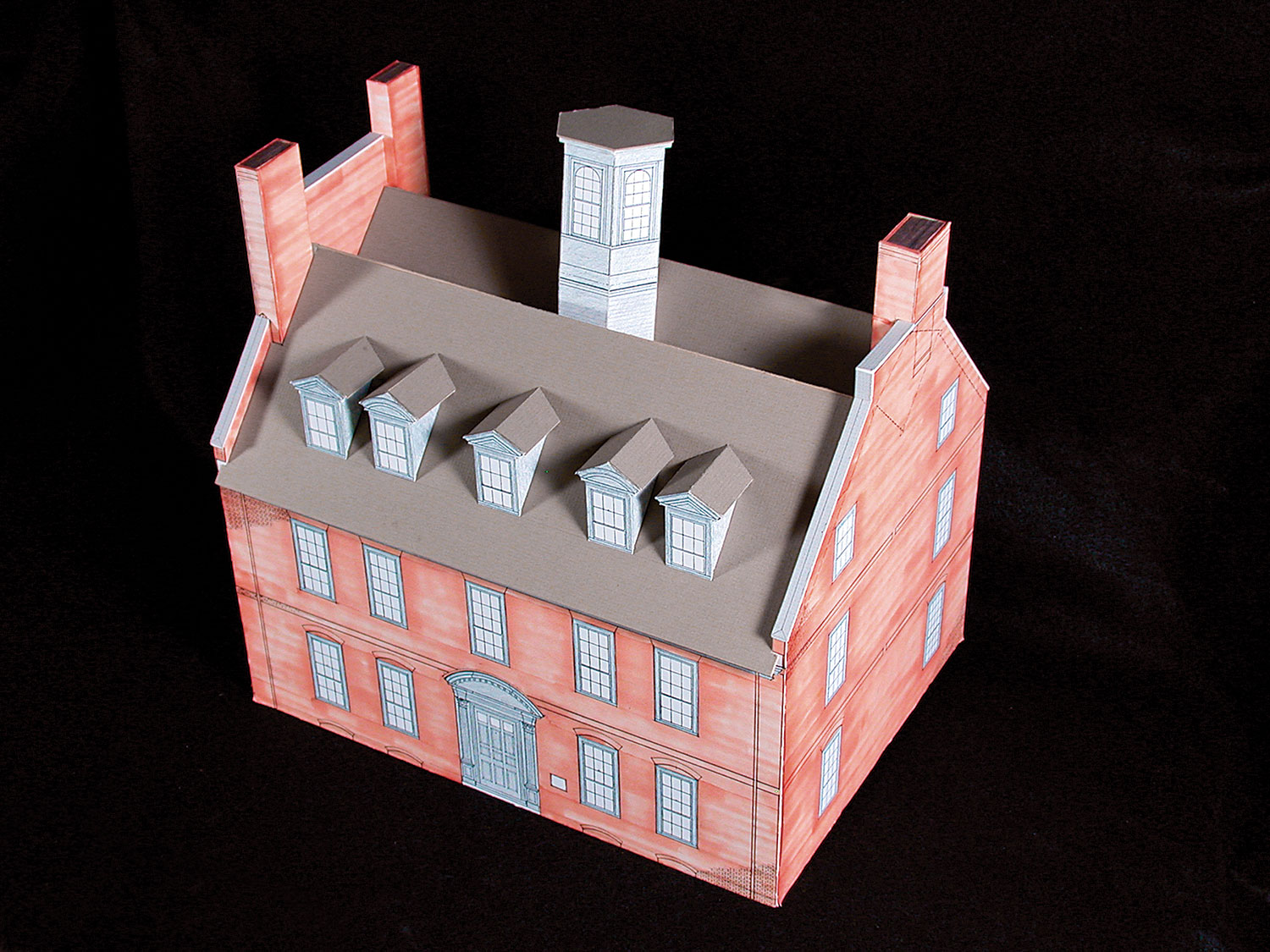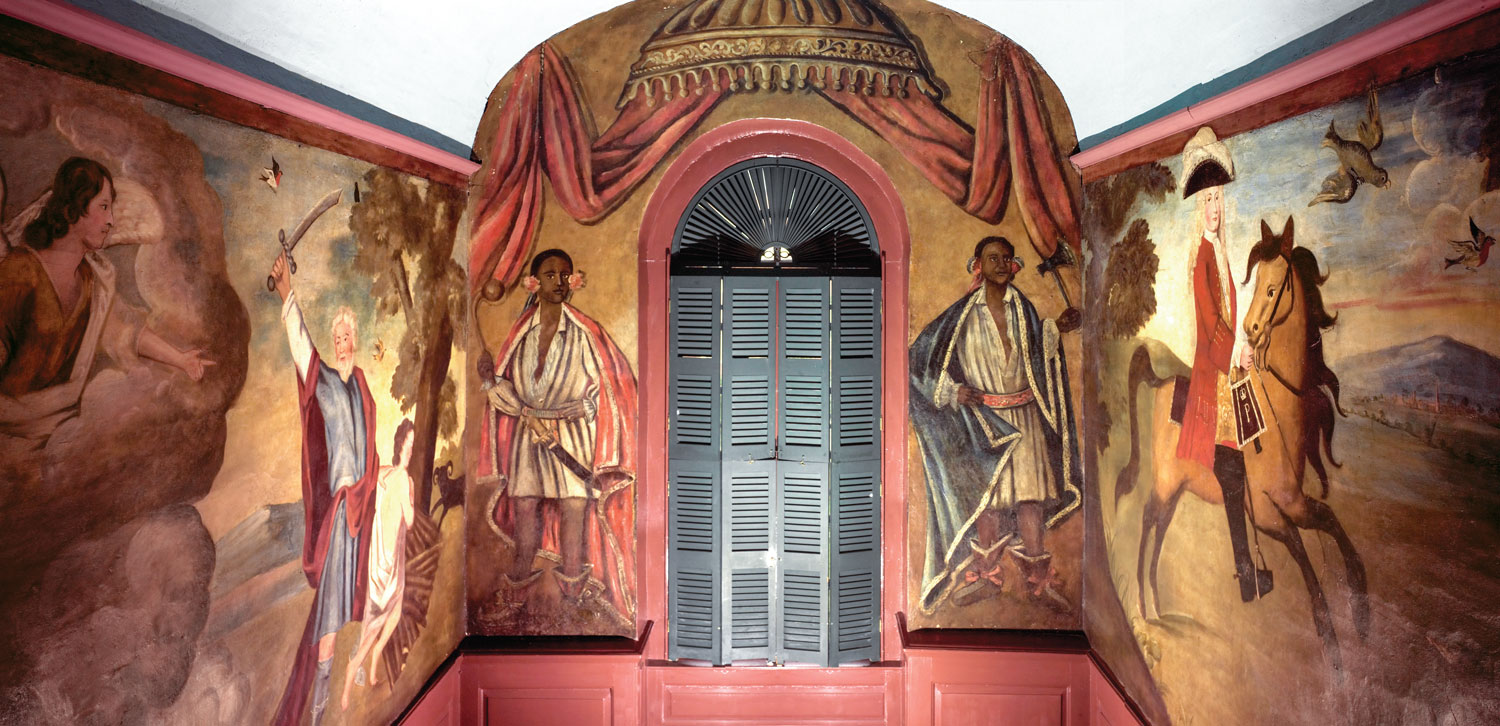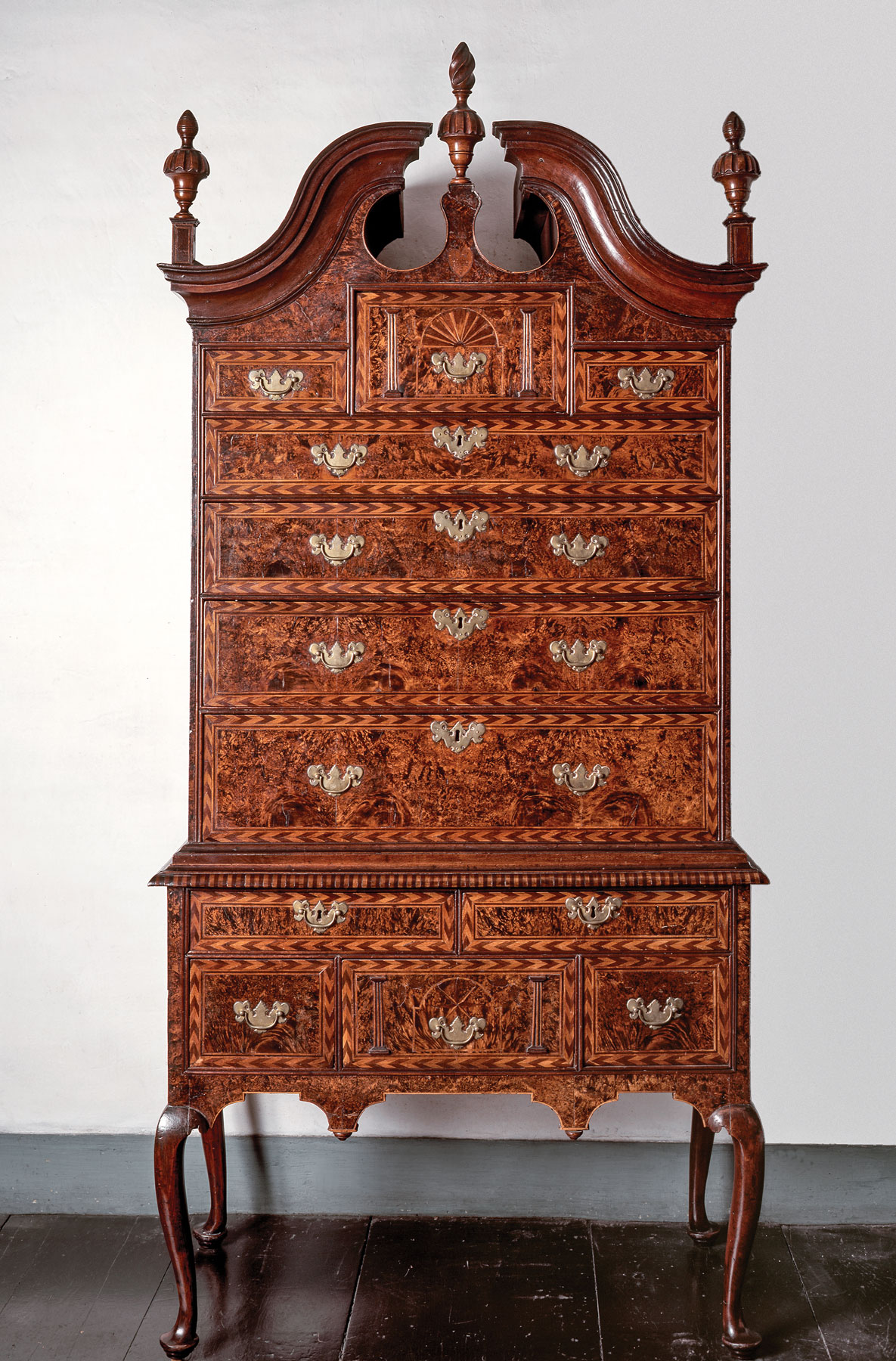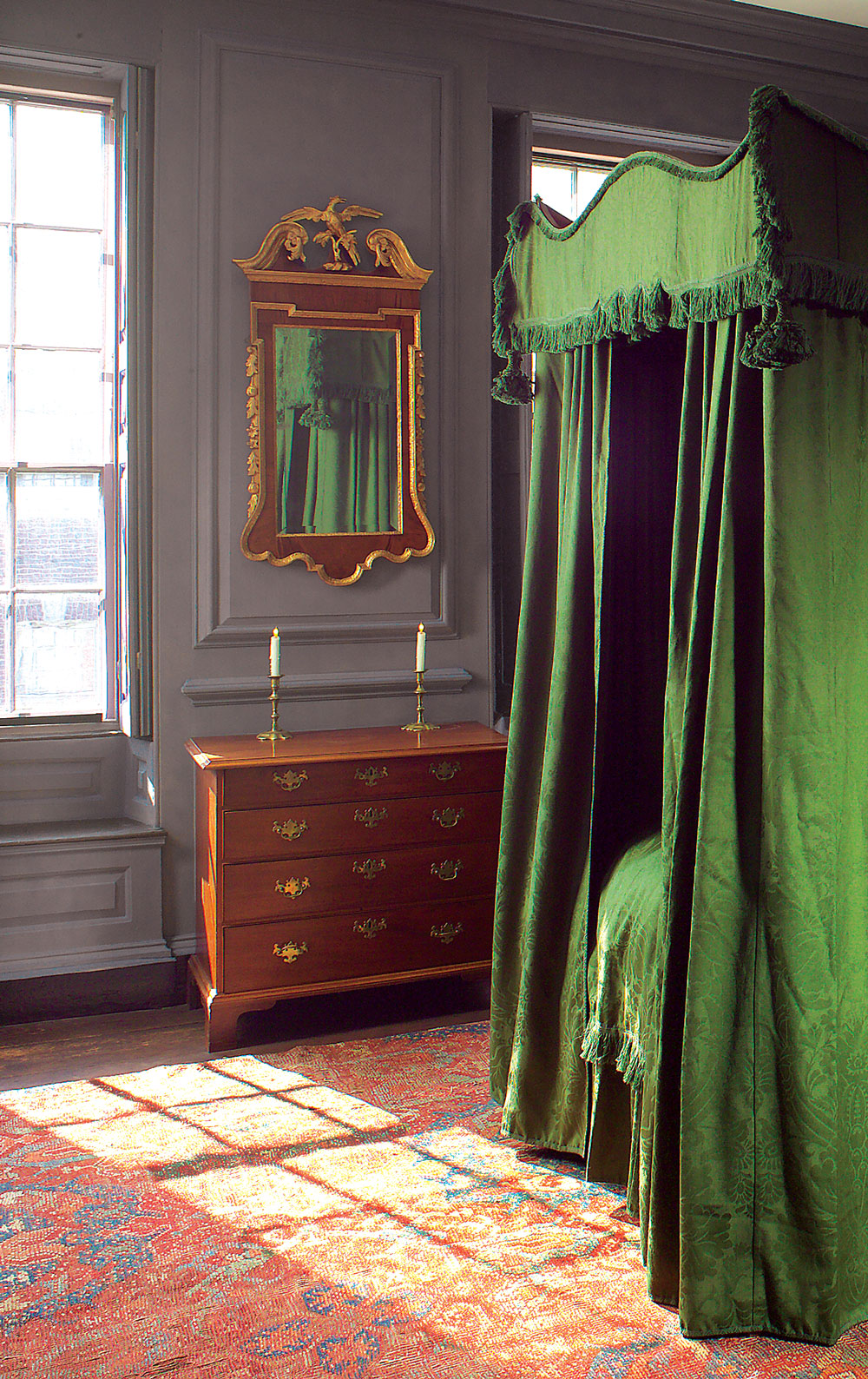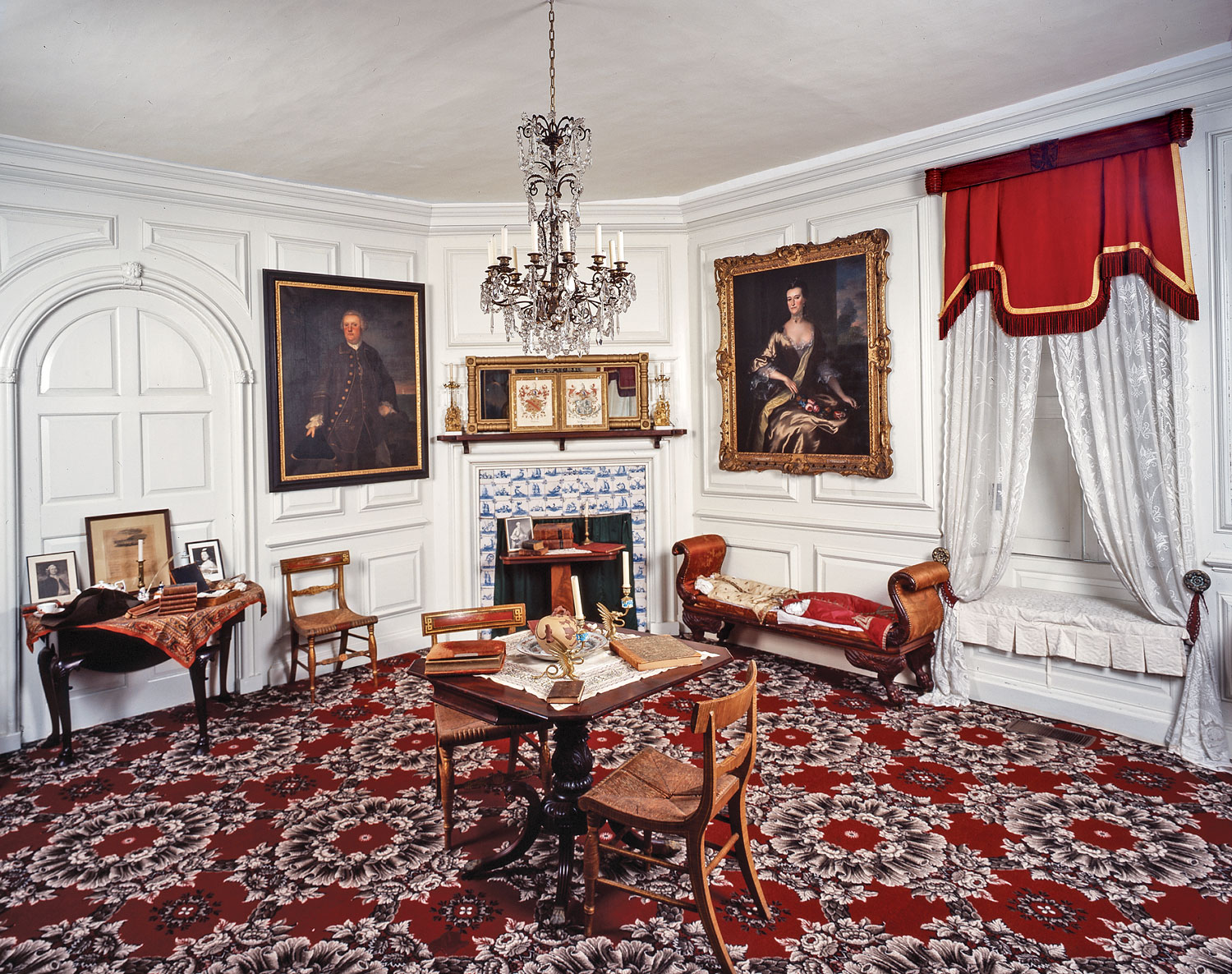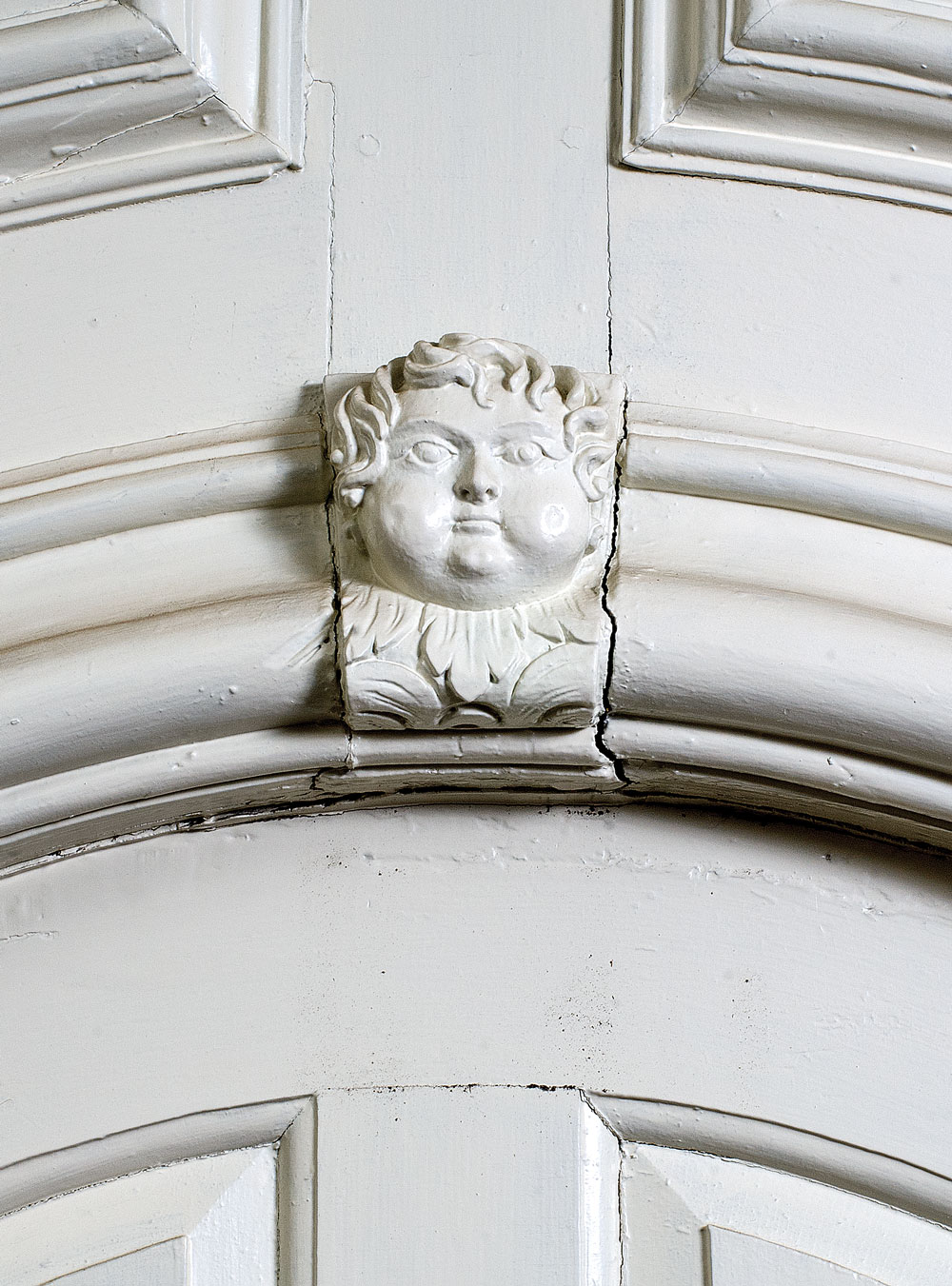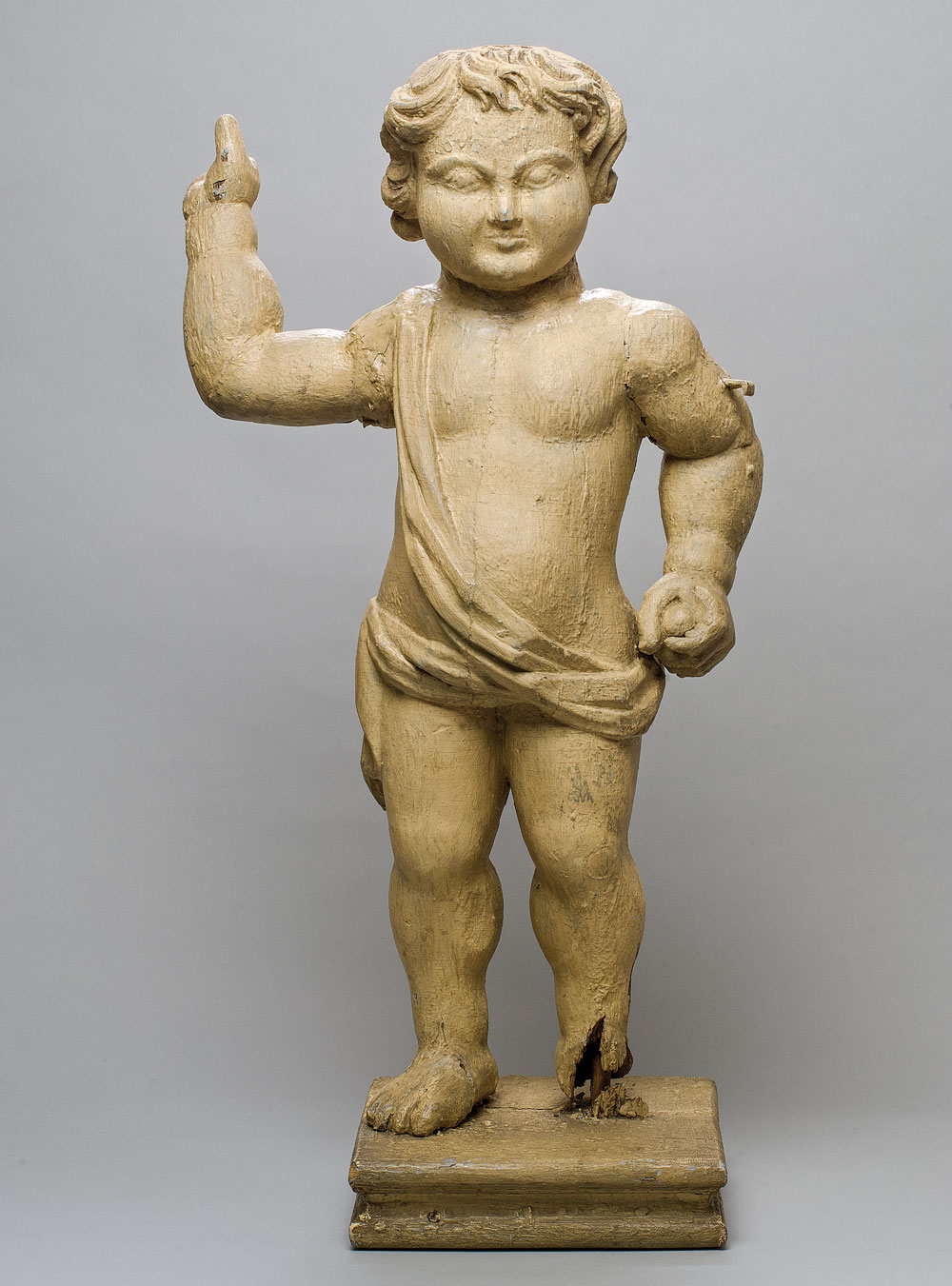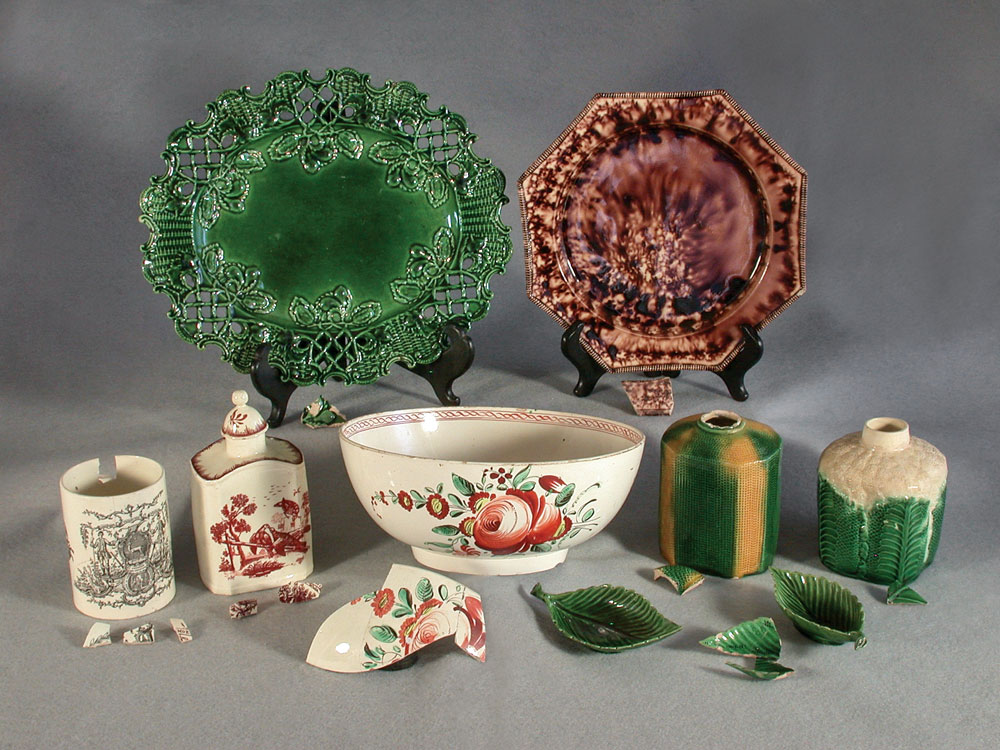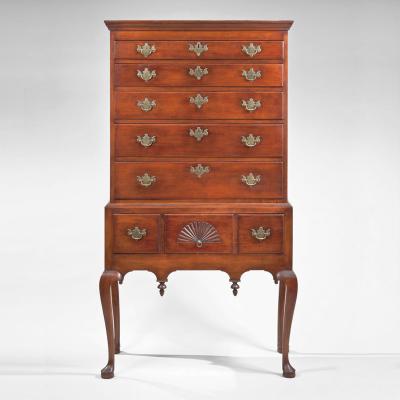Warner House, 1716–2016
This year marks the three-hundredth birthday of the oldest high-style, brick merchant’s dwelling in America—the Warner House in Portsmouth, New Hampshire (Fig. 1). In December 1715, Archibald Macpheadris, a Scots-Irish shipowner and sea captain from Northern Ireland, purchased land on Daniel Street, a short distance from his Piscataqua River wharf. He soon married Sarah Wentworth, the teenage daughter of the Lieutenant Governor, and built her the most stylish dwelling in the Piscataqua River region. It remained in the same family through female descent for almost 220 years.
The fine and decorative arts in this elaborate brick urban home were improved in large and small ways over the eighteenth and nineteenth centuries. After decades as a family summer home, it was sold in 1932 to an association that has preserved it as a historic house museum. Named the Warner House after a later owner, Jonathan Warner, who married Mary Macpheadris Osborne, the daughter of the original owners, the house showcases many original features and six generations of family furnishings.
Construction of the mansion began in 1716 under the direction of John Drew (1675–1732), a British master joiner who emigrated from the London area to Boston in 1713. Drew’s memorandum book (1707–1722), now at Strawbery Banke Museum, Portsmouth, clearly places him in Boston before coming to Piscataqua, as Portsmouth was once known, and demonstrates his familiarity with Palladio’s rules for architectural proportions based on classical Roman principles. Drew likely helped build some of the large Boston mansions erected after a 1711 fire there, which perhaps brought him to the attention of Captain Macpheadris. The design of the mansion, documented by Drew’s circa-1718 final bill (among family papers at the Portsmouth Athenaeum) demonstrates his familiarity with key features of large merchant houses in London and Deptford, where he worked from 1690 to about 1710.1
The building’s later eighteenth-century gambrel roof hides one of the more interesting features of its British origin, an “M”-shaped roof form typical of English urban building, where snow was seldom an issue. In New England, the owners soon discovered their error and covered over the center valley, partially hiding the lowest part of the surviving original cupola. Here, above the roof line, the captain and members of his family could sit on narrow benches and literally “watch their ship come in” on the nearby Piscataqua River.
The two Indian sachems depicted in the mural on the stair landing on either side of the arch window represent two of the four Native Americans taken by Pieter Schuyler to London to meet Queen Anne in 1710. Schuyler knew they would become a major attraction in London, and they were. Among other things, they pleaded successfully with Parliament to send warships to support the colonists in the battle with the French for Canada.
The murals, the earliest Anglo wall paintings in situ in America, depict Etow Oh Koam, a Mohawk, on the left, and Ho Nee Yeath Taw No Row, a Mohican, right. The Abenakis, the dominant New Hampshire tribe, were absent from the voyage. Archibald Macpheadris traded with local Native Americans, who are said to have given him the rack of caribou antlers that still hang in the front hall. It is even possible that Macpheadris joined other members of the Scots Charitable Society in Boston who made the trip to London with Schuyler. If Macpheadris participated in the 1710 voyage, it would explain the presence of the mural. However, other colonial office holders had engravings of these native diplomats after the portraits painted by John Verelst in London. According to the late Mary Black, the Warner House mural portraits were likely painted by Nehemiah Partridge after mezzotints of Verelst. Partridge was a locally born artist who worked mostly in Boston and New York. The biblical figures Abraham and Isaac and an unknown horseman also in the mural were covered by sequential layers of wallpaper from the 1760s until 1853.
This spectacular chest is inscribed in the pediment “I.S., 1733” for its association with Capt. John Sherburne. It comes from one of Warner’s heirs, Elizabeth Warner Sherburne, who moved into the house with her children and worldly possessions prior to Warner’s death in 1814. The dazzling veneers are maple, and further decoration is provided by walnut and white pine inlays. It is the earliest dated example of Queen Anne furniture in America. Though it relates to pieces made in Boston, it was probably made in the Portsmouth area, as certain construction details and its lively combination of inlays and veneers point to a local maker. Its value after Jonathan Warner’s death was given as £12, a substantial amount for a piece of furniture at that time. The high chest was returned to the house, as has much other furniture in recent decades, from family descendants.
The house contains five of the six Blackburn portraits of family members painted in Portsmouth, several signed and dated 1761. Blackburn wasn’t skilled in rendering bodily proportions, and his faces lack character. His real talent was painting fabrics, at which he was masterly. He made the mistake of teaching the young John Singleton Copley how to capture rich textiles in paint. Copley soon reigned in the portrait world, while Blackburn’s career faded. Shortly after painting the Warner clan, Blackburn returned to London.
The most successful portrait is the one of Polly (baptized 1749–died ca. 1769), Jonathan’s only surviving child. She was a daughter by his first wife, who died. As he and Mary had no children, Polly was a favored child. She was eleven or twelve when Blackburn captured some of her youth and movement. Her pet bird is charmingly done, and the gold satin and lace of her gown superb. But it is the sense of liveliness that sets her portrait apart from the others. This is the most borrowed item in the Warner House collection, usually joining other children in portrait exhibitions.
Along with Polly Warner, Blackburn painted Sarah Wentworth Macpheadris Jaffrey, Archibald’s widow, who later married a neighboring gentleman, George Jaffrey, and Mary Macpheadris Warner, the wife of Jonathan Warner. Blackburn’s portrait of Jonathan Warner is now in the Museum of Fine Arts, Boston. The portraits of two of Warner’s brothers, Samuel and Nathaniel, are in the Warner House.
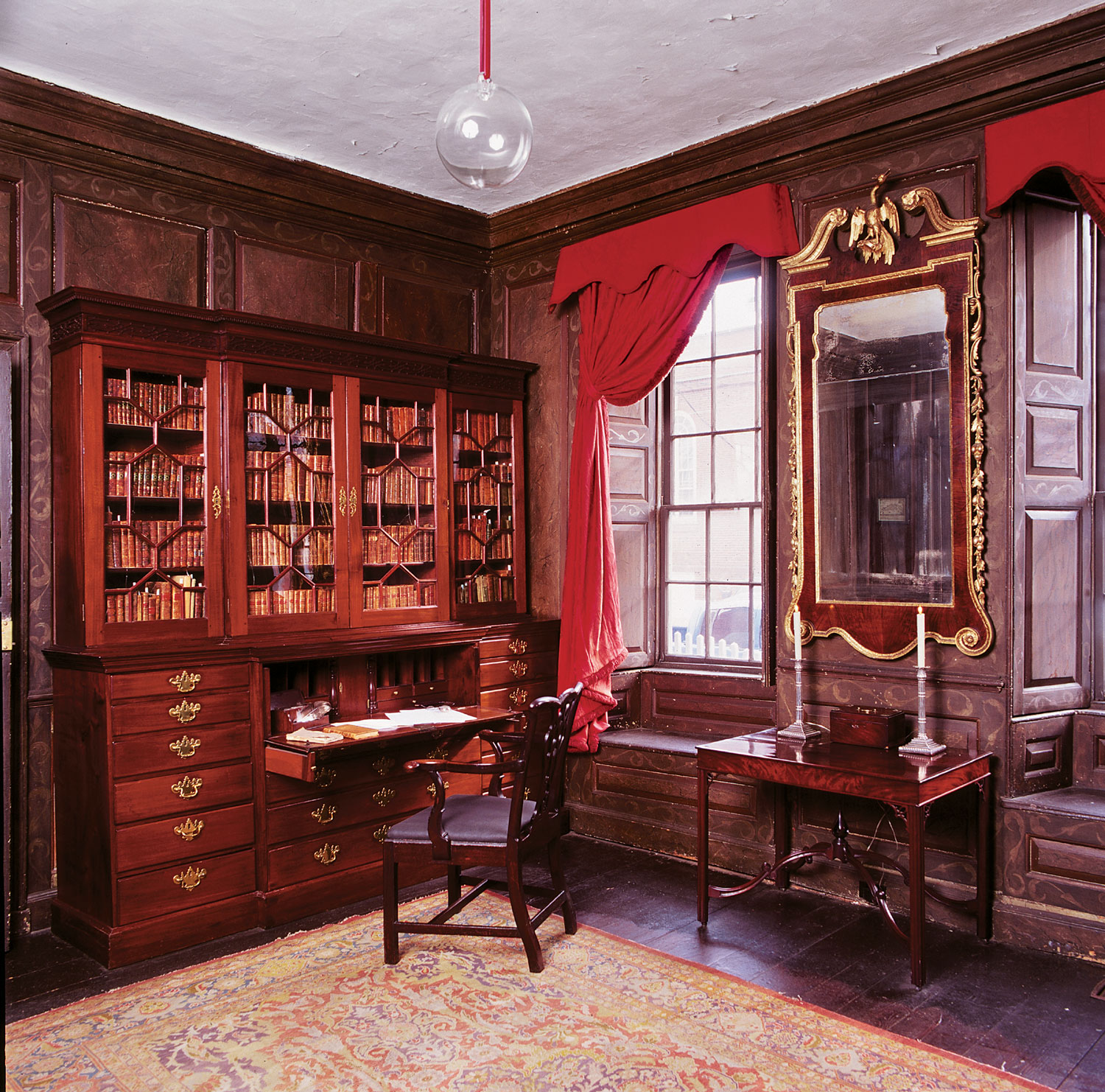
- Secretary bookcase, attributed to Robert Harrold (w. 1765–1792), ca. 1765–1775. Mahogany, H. 95¼, W. 92¾, D. 21½ inches. Gift of Mrs. John Curtis (1980). Tea table, attributed to Robert Harrold. Mahogany, maple and white pine, H. 27¼, D. 35⅝, W. 23½ inches. Gift of Harriet Langdon Pruyn Rice in memory of Caroline Eustis Peabody.
Jonathan Warner commissioned this large mahogany desk and bookcase from Robert Harrold, a recent émigré cabinetmaker from London, during the 1760s. It provided not only a working desk for him, but also a glass-fronted bookcase to display the collection of 150 books his daughter, Polly, received from an uncle in London.2 Evidence that the bookcase was made for its present corner spot is proved by its exterior, which is mahogany except for the far right side of pine; flush against a wall, it was not meant to be seen.
Because of its weight and proportions, later wall paints were simply applied around its outer edges. When the Warner family left the house around 1930 and the secretary was removed, the marbleized wall treatment behind it from the Macpheadris era was exposed for the first time in more than one hundred and fifty years. The original painted wall decoration was replicated after the house was established as a museum. Color analysis was not undertaken then and it is presumed that the background was likely originally the reddish brown that Macpheadris preferred in the hall and parlor.
In front of what Warner’s inventory described as the “large mahog’y Bookcase and sett of Drawers” stands a distinctive table, also attributed to Robert Harrold. The mahogany, maple, and white pine tea table is of a style found in several leading Portsmouth houses. This one descended in another Whipple family of Portsmouth unrelated to Amiel Weeks Whipple who married Eleanor Sherburne in 1843.
The main parlor bedchamber is restored to the period of Jonathan Warner, 1760–1814. Analysis of the wall treatment showed the paint incorporated smalt (ground cobalt-blue glass) from the top of the molding to the black-painted baseboard that may date to this period or earlier. During restoration, the smalt was sprayed onto the walls that had been covered with a coat of lavender paint, and then, following eighteenth-century instructions, pressed in with a soft cloth. After drying, a feather was used to remove the loose granules. This is the only smalted room yet found in this country, though it was readily available in contemporary store inventories for use by sign makers. Green damask bed hangings were listed in Jonathan Warner’s inventory. The present examples are copied from fragments of period hangings in Winterthur Museum. The green color was suggested by John Singleton Copley’s portrait of Nicholas Boylston in his green damask silk now in the collection of Harvard University.
This parlor or “eating room” (as it was called in one early inventory) is interpreted to the family’s nineteenth- and early twentieth-century occupation. The fireplace, reduced in size in about 1760, gained two extra rows of original Delft tiles (taken from the opposite small parlor fireplace), when it was redone after Jonathan Warner married into the family.
After Warner’s 1814 death, Sherburne heirs redecorated the room. Several of the objects, like the Blackburn portraits, remained. The original Classical center table was returned to the house as a gift from Wendy Cooper. The settee, one of an original pair acquired in the 1820s, came home through a family descendant.
(left) This cherubic face within the elaborate original raised paneling of the parlor, which Drew’s bill designated a “Dining room,” looks down from an arch above a now-missing “beaufat,” or arched-top cupboard. It probably had a carved shell imitating the exterior arch and likely held a tea service and other materials of entertainment.
(right) A pair of putti, both now owned by the Portsmouth Historical Society, came from Jonathan Warner’s rural farmhouse outside the city. It is now believed they may have been part of John Drew’s original “front door wth ornament,” relocated to the farm well after the original door surround was replaced. If so, these ornamental carvings were components of a bracket supporting a flat hood, as suggested by evidence in the brickwork, in the manner of larger merchant houses of London in that day.
Ceramic collectors have given or loaned a wide range of eighteenth-century ceramics to the museum, based on modern archaeological evidence of their use at the Warner House. Just one example of dozens of forms and bodies recovered from the site are these shards of 1760–1780 Staffordshire creamwares next to complete forms donated or loaned to the Warner House by a group of generous collectors. Especially rare and beautiful are a pair of 4⅝-inch green-glazed pickle dishes identified by the matching shards. The Warners also owned examples in the form of cauliflowers and melons, plates of green and tortoiseshell ware, as well as polychrome creamwares. Similar evidence of imported eighteenth-century coarse lead- and salt-glazed earthenwares, refined lead-glazed blackwares, redwares, and agate wares, salt-glazed stonewares, and Chinese export porcelains have also been identified from the archaeological excavations at Warner House.
This August 1915 photograph of Gardner Swan wearing Jonathan Warner’s tricorn hat and other family costumes was one of several Colonial Revival reenactments, with family members playing their ancestors. (Mr. Swan soon thereafter became the husband of Warner descendant Polly Penhallow). These photos were the price for Nutting gaining access to this treasure house to document its heirlooms with his camera. By the 1920s, only two aged inhabitants were returning annually from Boston to summer in the old house. By then, waterfront Portsmouth had so decayed that none of the younger family members were interested in maintaining the house. Acquired for preservation virtually empty of any furnishings during the Great Depression, over the last thirty years the extended Warner family has returned many objects to conserve and interpret the rich history of this renowned landmark.
The Warner House, located at 150 Daniel Street, Portsmouth, N.H., is open May through mid-October, Wednesdays through Mondays. Call 603.436.5909 or visit www.warnerhouse.org for information about events, news, or the exhibit Three Centuries of Dining at the Warner House. The exhibit The Warner House at 300! is on view through September 2, 2016 at Discover Portsmouth, 10 Middle Street; visit www.portsmouthhistory.org for more information.
-----
Joyce Geary Volk is an art historian trained at the Institute of Fine Art, New York University with a specialty in decorative arts. She served for many years as curator of the Warner House and edited the book A Rich and Colorful History (Portsmouth, NH: 2006).
Richard M. Candee is Professor Emeritus of Preservation Studies, Boston University and served as chair of the Warner House Association during the research and planning for a reinstallation and reinterpretation of the house in the 1990s.
This article was originally published in the Autumn 2016 issue of Antiques & Fine Art (AFA) magazine, a fully digitized version of which is available at afamag.com. AFA is affiliated with Incollect.
2. Polly’s uncle charged the books to her father’s account and sent them unbound, both because of his financial strains. Once in Portsmouth, they were bound in tan calf, with red and gold trim, each stamped in gilt “Miss Warner” on the front boards. Polly’s death some four years later preserved this rare evidence of elite social edification in America.















